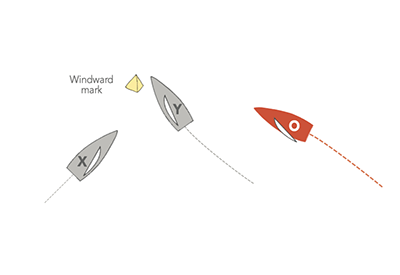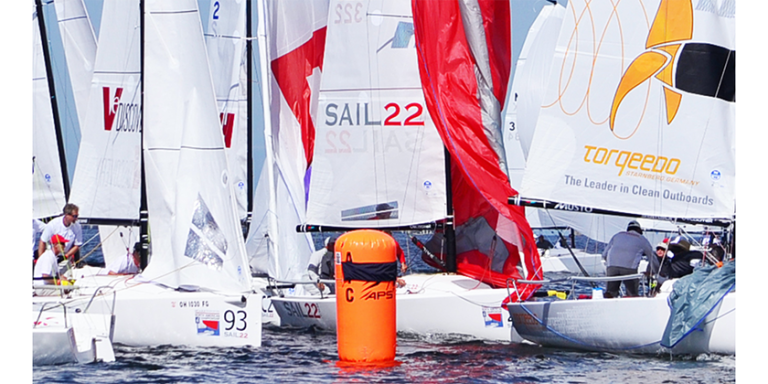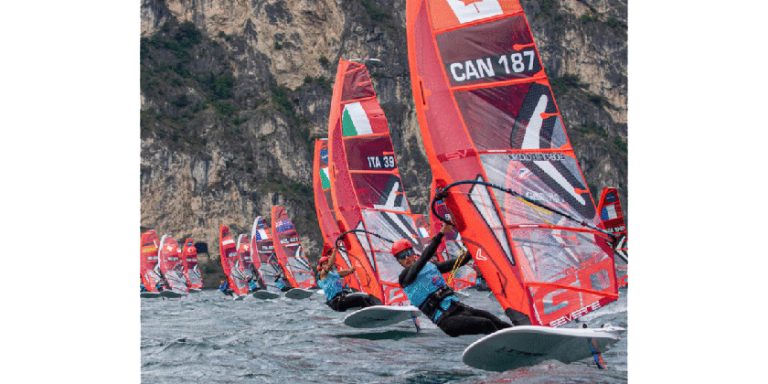Speed & Smarts: Mark-Rounding Principles Part 2 – Before Rounding Each Mark, Have a Plan for the Next Leg

October 5, 2022
Almost every sailor realizes the importance of making a strategic plan for the first leg before they start the race. But how many of those sailors also develop a strategy for every other leg in the race?
It’s tough to make a gameplan for the second leg before starting the race, but you should do this sometime before you begin that leg. It’s much too late if you round the windward mark and then ask your crew, “OK, which way should we go on the run?” By that time you have likely missed your best chance to pursue the optimal strategy.
Instead of waiting until the last minute, look ahead to the next leg several minutes before you reach the mark. Talk about what you see (eg wind pressure and the angle of other boats) and discuss your tactical and strategic options. It’s good to do this early since certain mark-rounding moves (eg a jibe set) require some planning before you get to the mark.
Your strategy for the next leg doesn’t have to be complex; it could be something simple like, “We will do a bearaway set and play the right side of the run where there is more wind.” Or “We are going to round the leeward mark and then tack to get the shift on the left.” It’s critical to do this before you round the mark because it often affects the rounding you make.
Use your next-leg strategy to plan the rounding
There are two important things that you must do every time you round a mark: 1) get around that mark as fast as possible; and 2) set yourself up to sail the next leg quickly. A fast rounding is not helpful if it means you must sail the wrong way at the start of the next leg. So it’s key to plan your rounding with the next leg in mind. Here are two examples of how to do this (or how not to do it) when you want to jibe at the windward mark:

Above: When planning a jibe set, approach the mark on starboard tack and slightly overstood so you will have less of a turn and a little extra speed for this maneuver. Do not approach the mark on port tack (X) or on a thin starboard layline (Y).
Below: When planning a jibe set, position yourself to round the windward (or offset) mark on the inside, close enough to touch it. Don’t round the mark overlapped on the outside (Z) since you won’t be able to jibe until (if) the inside boat (O) does!

Round each mark so you are close enough to touch it.
If you want to get around a mark as quickly as possible, it almost always pays to cut close enough so you could lean out and touch the mark. This will ensure you sail the minimum distance needed to round that mark – and traveling a shorter distance usually translates into sailing the course faster.
For every foot or yard that you leave between your boat and the mark, you actually lose twice this distance in the race. That’s because when you sail past the mark you must sail that far again just to get back to the mark. So, pass as close to the mark as you can without any risk of actually hitting it.
Of course, there are a few times when it’s OK to round farther from the mark – like at a windward mark when there is a lot of scope on the anchor line, or at a leeward mark when you are trying to sail around the outside of a pack of boats. But generally, you should round very close to each mark, even if this means you must slow down (at a leeward mark, for example) so you don’t get stuck on the outside of a pinwheel of your competitors.
After rounding the mark, delay non-essential clean-up.
After the start, the most critical part of any race may be the minute or so just after you round each mark. That’s when you’re fighting to get the boat going fast in the right direction amidst a bunch of bad air and choppy waves. During this time, it’s critical to have 100% focus on sail trim, weight placement, steering, tactics, and strategy. It is not a time when you want half the crew (or more) to be distracted by cleaning up after the mark rounding. Once you’ve rounded the mark, allow your team to perform only the jobs that are absolutely essential. For example, you have to stow the spinnaker, so it won’t blow away and make sure the sails are clear to tack. Delay all other non-critical jobs until later in the leg when you are sailing at full speed in clear air – then have one crew at a time work on cleanup. An early takedown can help a lot by allowing the crew to perform (almost) all necessary clean-up before your bow even reaches the mark. That way they are free to concentrate fully on speed, tactics, and strategy as soon as you round the mark.
Next time, more on Mark maneuvers in Part 3
 Dave Dellenbaugh is the publisher, editor and author of Speed & Smarts, the racing newsletter. He was the tactician and starting helmsman on America3 during her successful defense of the America’s Cup in 1992 and sailed in three other America’s Cup campaigns from 1986 to 2007. David is also two-time winner of the Canada’s Cup, a Lightning world champion, two-time Congressional Cup winner, seven-time Thistle national champion, three-time Prince of Wales U.S. match racing champion and past winner of the U.S. Team Racing Championship for the Hinman Trophy. He is currently a member of the US Sailing Racing Rules Committee (and was its chairman from 2005-2008).
Dave Dellenbaugh is the publisher, editor and author of Speed & Smarts, the racing newsletter. He was the tactician and starting helmsman on America3 during her successful defense of the America’s Cup in 1992 and sailed in three other America’s Cup campaigns from 1986 to 2007. David is also two-time winner of the Canada’s Cup, a Lightning world champion, two-time Congressional Cup winner, seven-time Thistle national champion, three-time Prince of Wales U.S. match racing champion and past winner of the U.S. Team Racing Championship for the Hinman Trophy. He is currently a member of the US Sailing Racing Rules Committee (and was its chairman from 2005-2008).
You can subscribe to the Speed & Smarts newsletter HERE.















